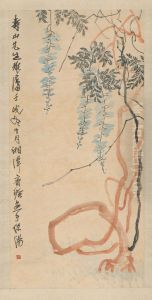Qi Baishi Paintings
Qi Baishi was a renowned Chinese painter, known for his whimsical and innovative style. Born on January 1, 1864, in Xiangtan, Hunan Province, Qi came from a humble peasant background. Despite the financial hardships of his early life, Qi developed a keen interest in art and poetry. Initially, he worked as a carpenter but continued to nurture his passion for painting and calligraphy in his spare time.
Qi Baishi's artistic journey was largely self-taught. He traveled across China, learning from ancient masters' works and drawing inspiration from the country's vast landscapes and rich cultural heritage. In his forties, he moved to Beijing, where his career as an artist truly began to flourish. Qi's style evolved over the years, and he eventually developed a distinctive approach that combined traditional Chinese techniques with his own creative interpretations.
Best known for his shuimo (水墨) ink wash paintings, Qi Baishi's subjects included landscapes, animals, and plants, with a particular fondness for depicting shrimp, which became one of his artistic hallmarks. His works are characterized by their simplicity, vivid colors, and the expressive use of ink. Qi Baishi was also a skilled seal carver and calligrapher, and his seals often accompanied his paintings.
Qi Baishi's art was well-received both in China and internationally. In 1953, he was elected as the president of the China Artists Association. His recognition extended beyond his home country, and his works were exhibited worldwide. Qi continued to paint well into his nineties, maintaining an active and prolific career until his death on September 16, 1957, in Beijing.
Throughout his life, Qi Baishi's work reflected a deep appreciation for the beauty of the natural world and the simplicity of everyday life. His legacy endures, and he is remembered as one of the most influential figures in the history of modern Chinese painting. His works continue to be highly valued and collected, with some fetching record prices at international art auctions.
